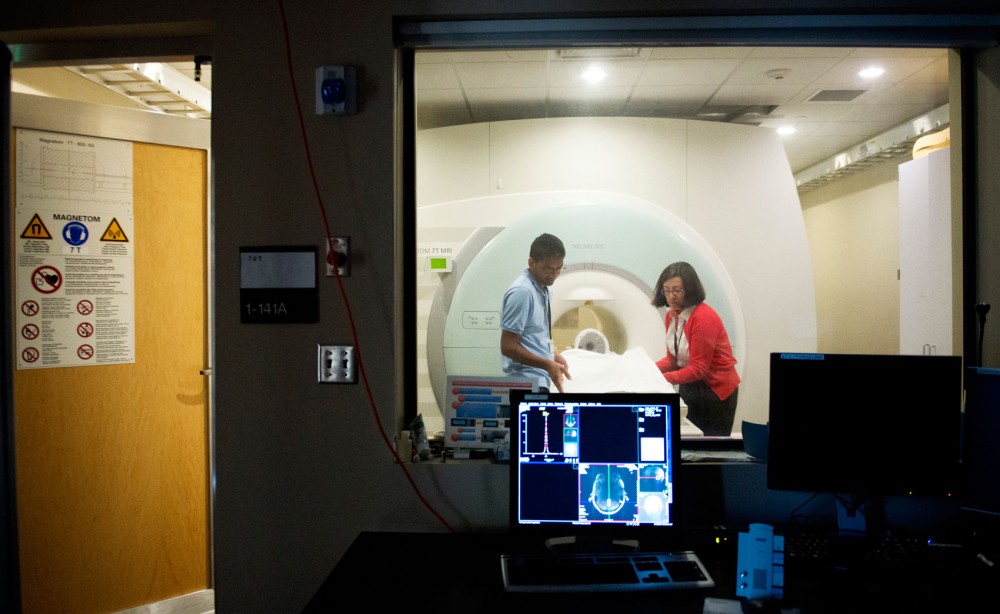University of Minnesota researchers have discovered they can use an old drug in a new way to possibly slow the progression of brain diseases.
Degenerative diseases like Parkinson’s and Gaucher’s decrease antioxidant levels in the brain, which can reduce the number of brain cells and affect patients’ motor skills.
In a pilot study, University researchers gave the drug N-acetylcysteine (NAC) to nine volunteers through an IV. All of the subjects’ brains showed increased levels of the antioxidant glutathione — 30 percent on average. The study didn’t prove that the drug will slow disease progression, but Gulin Oz, radiology associate professor and study co-author, said “the doors are open.”
Research associate Melissa Terpstra said the results were exciting because all of the patients responded positively to the drug.
“Being actually able to change brain chemistry is not an easy thing to do,” she said. “It’s not very common.”
Although the results don’t point to a cure for the diseases, they make way for further study on how NAC can help the brain.
“If we can slow the progression, maybe we can find a cure,” said Mary Holmay, pharmacy doctoral candidate and lead author of the study.
Few treatments currently exist for Parkinson’s disease. One drug works early in the disease and has many side effects, at some point making the symptoms worse.
Deep brain stimulation also has potential, but it can be dangerous because patients must have probes implanted in their brains.
“When it works, it’s like a miracle,” Oz said. “But it doesn’t always work, so still a lot of people are suffering.”
If University researchers can make pill or tablet forms of NAC, it could be another option to treat the diseases. Researchers found NAC helps protect the brain from losing antioxidants, but they still need to understand how it changes the brain’s chemistry.
“We haven’t cured their symptoms,” Terpstra said, “but we are kind of guiding the protocol to giving medicines.”
NAC is a U.S. Food and Drug Administration-approved medication that’s currently used to treat Tylenol overdoses and carbon monoxide poisoning. It’s also sold in a powder form as an antioxidant supplement.
Since the researchers already knew NAC increased antioxidant levels in the blood, with this study they wanted to see if NAC behaved similarly in the brain.
James Cloyd, pharmacy professor and study co-author, said the team used Magnetic Resonance Spectroscopy, which is similar to an MRI, to quantify the changes in glutathione levels in the brain.
“So what we said was, ‘Let’s … put them in this magnet to measure their brain,” he said. “Let’s see if we can change brain chemistry.”
Holmay said MRS is a new method that “takes a particularly strong magnet” to measure the specific chemical levels.
MRI machines can’t measure the chemical and antioxidant levels, but MRS can, Oz said.
Paul Tuite, associate professor of neurology, said the next step is to see if an oral dose of NAC will also affect the brain and, if it does, how large a dose patients will need. The intravenous dose used in the study was the largest possible.
Cloyd said NAC leaves the body in about seven hours, meaning patients would have to take the drug a few times a day.
“Our presumption is that you’d need to take it on a regular, consistent basis to see the benefit,” he said.
If researchers can make NAC in a pill or tablet form, patients could easily take supplements themselves rather than going into the clinic for an IV dose.
A number of Oz’s family members have been affected by degenerative brain diseases, so she’s seen firsthand what they can do.
“The people who are getting them are helpless,” she said, “So if you can help in some way — toward a treatment or slowing the progression of these diseases — it would be very satisfying.”


